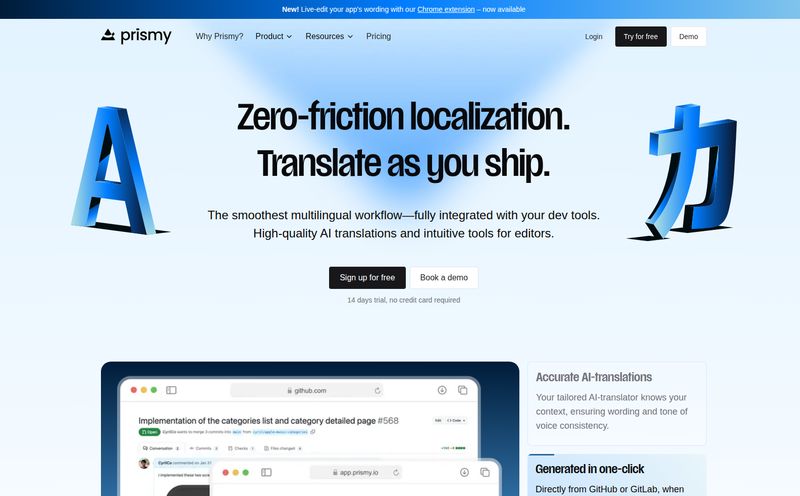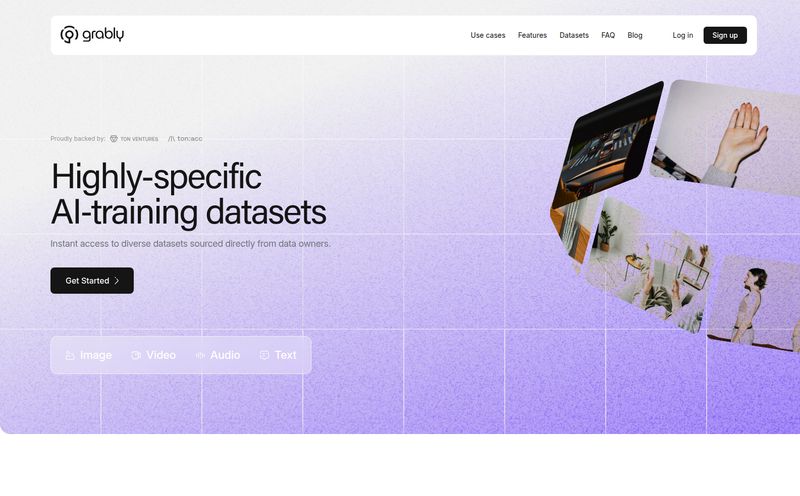The world of AI right now feels a bit like a gold rush, but instead of pickaxes and pans, we're all desperately scrambling for GPUs. Getting your hands on powerful compute is expensive, complicated, and sometimes, flat-out impossible. I’ve seen startups burn through their seed funding just trying to keep the lights on for their training models. It’s a massive barrier to entry, and honestly, it’s been a source of major frustration for me and my clients.
Every so often, a new platform pops up, waving a banner that reads, "We fixed it!" Most of the time, it's just a slicker UI on the same old expensive engine. But then I stumbled upon Lumino. Their homepage hits you with a pretty audacious claim: cut your ML training costs by up to 80%.
My inner skeptic, honed by years of sifting through marketing fluff, immediately raised an eyebrow. 80%? That's not just an improvement; that's a total game-changer. So, naturally, I had to dig in. Is Lumino the hero we’ve been waiting for, or is it just another drop in the crowded cloud computing ocean?
So, What Exactly is Lumino Supposed to Be?
At its core, Lumino is a global cloud platform built specifically for AI development and training. Think of it this way: if you wanted to build a race car, you could start by mining the iron ore yourself, smelting the steel, and machining every single bolt. That's kind of what setting up a full ML infrastructure on a traditional cloud provider can feel like. It's powerful, sure, but it's also a colossal amount of work that has nothing to do with actually driving the car.
Lumino wants to be your pre-built, high-performance engine. It offers an easy-to-use SDK (Software Development Kit) that promises to let you fine-tune massive models like Llama 3.1 with just a few lines of code. No more wrestling with compute instances, configuring environments, or hiring a whole MLOps team just to get started. The goal is to abstract away the painful parts so you can focus on what matters: building and training your model.
Breaking Down the Big Promises
A bold claim is one thing, but execution is everything. Lumino’s website lays out a few key pillars for how they plan to make AI development better. Let's pick them apart.
Radically Cheaper Training Costs
This is the headline act. The 80% savings figure comes from a fundamental shift in how they bill you. Instead of renting a GPU instance by the hour (and paying for it even when it's sitting idle), Lumino uses a “pay-per-training-job” model. You only pay for the exact compute you use while your model is actually training. Period.
Anyone who's ever forgotten to shut down an AWS instance and come back to a four-figure bill knows how huge this is. It takes the guesswork and the terror out of cloud bill roulette. The one catch? I couldn’t find a pricing page. Anywhere. I even got a friendly "Page not found" error when I went looking, which, for an early-access product, is almost charmingly honest. This means you can't do a quick cost comparison; you'll have to get in touch with them directly. It’s a bit of a hurdle, but not uncommon for platforms targeting serious developers and enterprises.
The Dream of Infinite Compute with Autoscaling
Tied directly to cost is their promise to "never run out of compute." This is achieved through autoscaling. In simple terms, the platform automatically assigns the resources your job needs, when it needs them. As your training demands spike, it scales up. When the job is done, it scales down to zero. This efficiency is the engine behind the pay-per-job model. You're not paying for a massive, overpowered server just in case you need it; you're getting precisely what you need, on demand. It’s smart, and it’s how cloud computing should have worked all along, in my opinion.

Visit Lumino
An SDK That Actually Seems Easy to Use
The developer experience is clearly a huge focus. The promise of deploying custom models in seconds with a simple SDK is music to the ears of any developer who's spent a week just trying to get their dependencies to play nice in a Docker container. By handling the backend grunt work, Lumino lets coders be coders, not amateur system administrators.
The GPU Ace Up Their Sleeve
This is where things get really interesting for me. One of the most compelling pieces of evidence on their site is a short but powerful quote from Andrew Stanco of EOTY. He says:
"The team at EOTY faced a critical deadline in order to train our model, but due to the GPU shortages of 2023 GPUs were nowhere to be found but the Lumino team delivered A100s and allowed us to start the project."
Whoa. For anyone not in the weeds, NVIDIA's A100s are the thoroughbreds of the AI world. They are powerful, sought-after, and have been notoriously difficult to procure. The fact that Lumino could apparently source and deliver these on a deadline when they were otherwise unavailable is a massive vote of confidence. It suggests they have some serious hardware connections and a supply chain that could be a lifesaver for teams under pressure. This isn't just a software platform; it's a hardware access play, too.
Thinking About Privacy and Trust
In 2024, you can't talk about AI without talking about data privacy and trust. Lumino seems to get this. They have features for keeping your data private and making models transparent and auditable through what they call "cryptographically verified proofs." This is a forward-thinking feature. It’s about creating a verifiable chain of custody for your models, proving how they were trained. As regulations around AI inevitably tighten, this kind of built-in compliance tool could go from being a nice-to-have to an absolute necessity. It shows they're not just solving today's problems, but thinking about tomorrow's as well.
So, What are the Potential Gotchas?
Okay, I'm excited, but I’m not throwing a parade just yet. No platform is perfect. Based on what I've seen, there are a couple of things to keep in mind.
- The Pricing Mystery: I've mentioned it before, but it bears repeating. The lack of a public pricing page is a friction point. You can't budget or compare without engaging their sales team. For a small team just wanting to experiment, this might be a non-starter.
- The Vendor Lock-in Question: Convenience always comes at a price. By building your workflow on Lumino's slick SDK, you're also tying yourself to their ecosystem. Migrating away from it could be more complex than moving between traditional cloud providers. It's the classic trade-off: do you want supreme ease-of-use or ultimate portability? You can't always have both.
It's still in "Early Access," so some bumps are expected. You have to weigh the potential for massive cost and time savings against the risk of betting on a newer platform. Personally, for the benefits on offer, it seems like a risk worth investigating.
Who Should Be Giving Lumino a Serious Look?
After going through it all, I have a pretty clear picture of who would get the most out of Lumino. This platform seems almost perfectly designed for AI startups or mid-sized companies that have a brilliant idea but don't have a dedicated MLOps division. It's for the research teams in larger organizations who are tired of fighting for resources and just want to run their experiments. And it's definately for anyone who's been burned by the GPU shortage and needs access to high-end hardware now, not in six months.
If you’ve already built a deeply complex, bespoke ML infrastructure that costs millions to maintain, this might not be a drop-in replacement. But for the 90% of other developers and businesses out there, this could be the shortcut you've been looking for.
Frequently Asked Questions About Lumino
- What is Lumino?
- Lumino is a cloud platform specifically for developing and training AI models. It aims to simplify the process with an easy-to-use SDK and significantly lower costs by charging per training job instead of per hour.
- How does Lumino actually save you money?
- The primary cost-saving mechanism is its “pay-per-training-job” model combined with autoscaling. You are not billed for idle compute time, which can be a huge expense on other platforms. They claim this can reduce ML training costs by up to 80%.
- What kind of GPUs can you access on Lumino?
- While a full list isn't public, they have demonstrated the ability to provide high-demand GPUs like the NVIDIA A100, even during shortages. This suggests they can source a wide range of powerful hardware.
- Is Lumino a good choice for projects with sensitive data?
- It appears to be. Lumino emphasizes data privacy controls and offers features for transparent and auditable model tracing using cryptographic proofs, which is a strong indicator that they take security and compliance seriously.
- Okay, so how much does Lumino cost?
- That’s the million-dollar question! As of now, Lumino does not have a public pricing page. It's in an “Early Access” phase, and you'll need to contact their team directly for a quote based on your specific needs.
- Is Lumino suitable for a beginner in machine learning?
- It seems like a great fit. By abstracting away the complex infrastructure setup, Lumino allows beginners and experts alike to focus more on the model itself rather than the underlying systems, potentially lowering the barrier to entry.
My Final Verdict on Lumino
So, is Lumino just hype? I don't think so. The problems it's trying to solve—exorbitant costs, hardware scarcity, and overwhelming complexity—are very, very real. The approach of combining a pay-per-job model with access to hard-to-find GPUs is not just smart; it's exactly what the industry needs right now.
Sure, the lack of public pricing is a hurdle, and being an early-access platform carries some inherent risk. But the potential upside is enormous. For any team feeling the squeeze of the current AI development landscape, ignoring Lumino would be a mistake. It’s one of the most interesting platforms I've seen in a while, and I'll be keeping a very close eye on it. This could be one of those tools that genuinely helps democratize access to powerful AI, and that's a future I'm excited to see.



